
Introduction
With
the exception of the Great Wall of China, the Maginot Line was the greatest
system of permanent fortification ever built, and probably the last. In spite of
this, it has remained relatively unknown as far as its technical construction
and history are concerned. What is known about it is its unenviable reputation
for being the greatest White Elephant of all times.
Many
writers, trying to justify a point of military futility, have seized upon the
Maginot Line as being the classic example, which is to ignore the fact that the
defence's fulfilled the purpose for which they were constructed- to stop a
German invasion of Alsace and Lorraine. The fact that they decided to invade
elsewhere is another matter. The Line has even been blamed for the fall of
France in 1940. The latter, however, was caused by a mixture of moral and
political degeneration and the blindness of the military authorities to the
development of warfare after 1918.
The reality of the Maginot Line remains as a monument to man’s technical
ingenuity, and, as an inanimate object, cannot be held responsible for the
blindness of its creators. There were, however, two lines: the real one and the
propaganda one. It is the latter which represents the myth.
I
use the term ‘Maginot Line’ throughout this page as this is the name
popularly associated with the pre-1940 French frontier defence's. The title,
however, was a figment of media imagination, coined in the 1930’s to simplify
complex military terminology.
André
Maginot was a politician who, among other things, secured the necessary funds
from an unwilling Chamber of Deputies to build
the defence's. It is one of the injustices of history that his name has been
unfairly coupled with something for which he was not technically responsible and
which was mainly built after his death.
The
many excellent studies of the Battle of France in 1940 all mention the Maginot
Line, but only in passing and without going into any detail. Informed literature
in English is non-existent. Anything written before the war was largely inspired
by propaganda motives or based on ‘official’ handouts. Only during the last
few years have a number of books, limited-circulation treatises and articles in
military journals appeared on the Continent.
It is only fairly recently that public interest in the subject has been awakened. Several of the forts have been restored and can be visited, A few of those are shown here. French official circles, however, remain silent, and the Maginot line is still a military secret at least in theory.
The Fortress of Fermont |
|||
|
One
of the three major fortresses of the La Crusnes Fortified Sector, Fermont
fortress (A2) stands in the Chiers valley between
The La Crusnes Fortified Sector was responsible for the frontier from Marville,
eighteen kilometers west of Longuyon, to Dudelange, about twenty kilometers
north of Thionville. The fifty kilometers of front were protected by three major
fortresses, four minor fortresses and thirty-six case-mates, stretching from the
minor fortress of Ferme Chappy (Al), to the west; to another minor fortress,
Aumetz (A7), to the east. There were also one shelter and five observatories.
The major fortress of Fermont was the second on the left of the La Crusnes
sector.
Fermont
had seven battle blocks and the usual two entrance blocks:
Block 1:
one 75mm turret, one GFM cupola and one LG cupola.
Block 2:
one MI turret and one GFM cupola. Block 3: one GFM cupola, two JM cupolas and
one observation cupola.
Block 4:
three 75mm embrasures, one GFM cupola and one JM cupola.
Block 5:
one 81mm turret and one GFM cupola.
Block 6:
one MI turret and two GFM cupolas.
Block
7: one 47mm AT/Reibel JM embrasure, one Reibel JM embrasure, one GFM cupola
and one LG cupola.
Its entrances were of the shaft kind. Protecting the munitions and supplies
entrance was a 47mm AT/Reibel JM embrasure, two GFM cupolas and one LG cupola.
A 47mm AT/Reibel JM embrasure and two GFM cupolas protected the personnel
entrance. Solder Florian Piton was killed when a 37mm anti-tank shell hit the slit of the GFM cupola (right) in which he was on watch at the personnel entrance. Florian Piton was buried on June 22 in a grave dug out of the wall of the main thoroughfare.
|
|
||
|
|
|||
 |
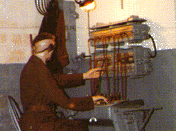 |
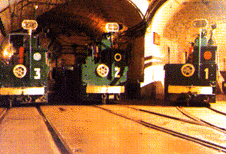 |
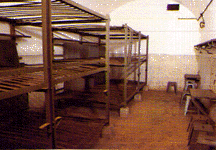 |
| The Main Corridor |
The Telephone Exchange for passing fire control orders between the observers the command post and the artillery blocks |
The small 600vdc electric trains used in the fort |
One of the bunk rooms |
|
Click here for a Map |
Fermont Official Website |
||
Click Here for a Map
One
of the four major fortresses of the Boulay Fortified Sector, the Hackenberg
fortress (A 19) stands in the Forêt des
Quatre Seigneurs, about fifteen kilometers east of Thionville, a few hundred
meters above the village of Veckring on the D60.
The
Boulay Fortified Sector was responsible for the frontier from Launstroff,
about ten kilometers east of Sierek to Coume, about five kilometers northeast
of Boulay. The sector was protected by four major fortresses, eleven minor
fortresses and seventeen casemates, from the major fortress of Hackenberg,
to the west, to the minor fortress of Mottenberg (A33), to the east. There
were also fourteen shelters and two observatories. Hackenberg was the first
fortress on the left wing of the Boulay sector.
|
|
|
The Munitions Entrance in 1998 |
|
|
|
An Original Plan of the Ouvrage |
Block
1: one Ml turret.
Block
2: one 75mm turret and two GEM cupolas.
Block
3: one 81mm turret and one GFM cupola.
Block
4: one Reibel JM embrasure, one 37mm AT/Riesel JM embrasure. One MI turret and
two GFM cupolas.
Block
5: three 75mm howitzer embrasures, two GFM cupolas and one LG cupola.
Block
6: one 135mm turret and one GFM cupola.
Block
7: one Reibel JM embrasure, one 37mm AT/Riesel JM embrasure, one MI turret and
two GFM cupolas.
Block
8: three 75mm howitzer embrasures and two GFM cupolas.
Block
9: one 135mm embrasure, one 135mm turret and two GEM cupolas.
Block
10: one 81mm turret and two GFM cupolas.
Block
11: one GFM cupola and one observation cupola.
Block
12: one GFM cupola and one observation cupola.
Block
21: two Reibel JM embrasures, one 50mm mortar embrasure and one GFM cupola.
Block
22: one Reibel JM embrasure, one GFM cupola and one JM cupola.
Block
23: two GFM cupolas and one LG cupola.
Block
24: two Reibel JM embrasures, one 50mm mortar embrasure and two GFM cupolas.
Block 25: one 75mm howitzer embrasure, one Reibel JM embrasure, one 50mm mortar embrasure and one GFM cupola.
The
entrance blocks led directly into the fortress. That for munitions and
supplies was protected by a 47mm AT/Reibel JM embrasure and two GFM cupolas,
and that for personnel by a 47mm AT/Reibel JM embrasure, two GFM cupolas and
one LG cupola. Manning the fortress were 42 officers and 1040 men of the 164ème
RIF and 153ème RAP. In June 1940 the fortress commander was Commandant Henri
Ebrard. In May 1940 the VI ème Corps d’Armée assumed tactical control
within the sector. The 51st (Highland) Division of the British Expeditionary
Force held the part of the line in front of the Hackenberg fortress until May
22 when it was relieved and assembled near Etain.
|
|
|
One of the Forts Electric trains, now used to carry passengers down to the Combat blocks. |
|
|
|
|
The Main tunnel looking back to the main entrance |
One of the Fort's Generator's |
|
|
|
|
The Power house, from here power was distributed to other parts of the Fort and to the Forts own electric trains at 600VDC. |
The Main Kitchen, Here the food was prepared for the forts 1100 Officer's and Men. The food was collected and taken to the combat blocks to be eaten. The fort had its own wine cellar and walk in freezer.
|
A view down the main corridor looking
towards the combat blocks the door is
damaged at the bottom, it was damaged
when the Germans blew up the main
magazine before leaving the fortress. the door bent
because the Germans had previously cut
the lower portion of the frame away to
allow large machine to be brought in.
one of Hackenberg's 135mm guns this one is in
block nine you can also see the empty cartridge chute,
to expel empty cases down to a lower level,
and the monorail system used to bring ammunition up
from the block's ready use magazine in folding containers.



Here we can see one of the famous retracting turrets for a 135mm lance Bomb (Mortar), the turret in its entirety with mechanism, Armour and its counter weight weighs nearly 270 tons. the dome has 35cm of Armour plate weighing 30 tons alone. it contains two 75mm guns 1933 model's which could be completely retracted or raised 70cm to fire in any direction. It had a maximum range of 11km at 20 rounds per minute, with a 30 round per minute maximum rate of fire for short periods.
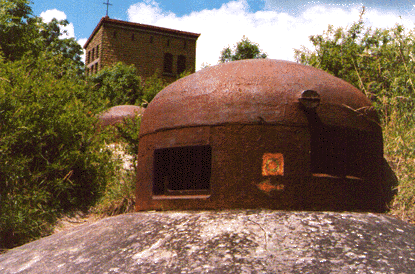
This is an observation cupola on the highest point
above the fort with the Chapel in the background
the original chapel was destroyed during the war
this new one was built after the war.
Location Map Click Here
Immerhof
has its own web site click here
![]()

One of the four minor fortresses of the Thionville Fortified Sector, Immerhof fortress (A10) stands just north of the D15, between Kanfen, to the north-west, and Soetrich, to the east, about ten kilometers north of Thionville. The Thionville Fortified Sector was responsible for the frontier from Dudelange, twenty kilometers north of Thionville, to Launstroff, about ten kilometers east of Sierck. With the Moselle valley running through its center, the sector was highly vulnerable and it had been well protected with seven major fortresses, four minor fortresses and seventeen casemates. The fortifications stretched from the major fortress of Rochonvillers (A8), to the west, to another major fortress, Billig (A18), to the east. There were also eighteen infantry shelters and four observatories. Immerhof was the third fortress from the left of the Thionville sector.
The Immerhof fortress had three battle blocks and one entrance block:
Block 1: one Ml turret and two GFM cupola
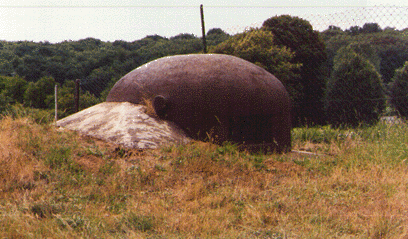
Block
2: one MI turret and two GFM cupolas.
Block
3: one SImm turret, one GFM cupola and one Reibel JM embrasure.
A
47mm AT/Reibel .JM embrasure, two GFM cupolas and one LG cupola protected the
entrance block.